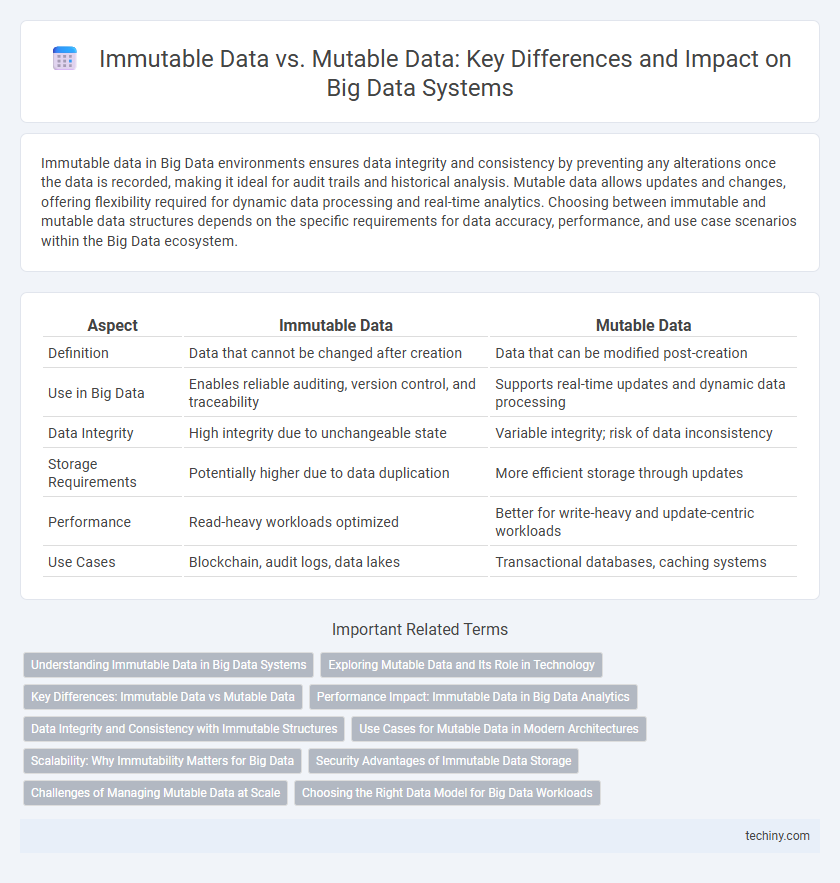Immutable data in Big Data environments ensures data integrity and consistency by preventing any alterations once the data is recorded, making it ideal for audit trails and historical analysis. Mutable data allows updates and changes, offering flexibility required for dynamic data processing and real-time analytics. Choosing between immutable and mutable data structures depends on the specific requirements for data accuracy, performance, and use case scenarios within the Big Data ecosystem.
Table of Comparison
| Aspect | Immutable Data | Mutable Data |
|---|---|---|
| Definition | Data that cannot be changed after creation | Data that can be modified post-creation |
| Use in Big Data | Enables reliable auditing, version control, and traceability | Supports real-time updates and dynamic data processing |
| Data Integrity | High integrity due to unchangeable state | Variable integrity; risk of data inconsistency |
| Storage Requirements | Potentially higher due to data duplication | More efficient storage through updates |
| Performance | Read-heavy workloads optimized | Better for write-heavy and update-centric workloads |
| Use Cases | Blockchain, audit logs, data lakes | Transactional databases, caching systems |
Understanding Immutable Data in Big Data Systems
Immutable data in Big Data systems refers to datasets that, once written, cannot be altered or deleted, ensuring data integrity and consistency across distributed environments. This characteristic is crucial for auditing, compliance, and historical analysis, as it guarantees an unchangeable record of data transactions. Immutable data storage methods, such as append-only logs and versioned data lakes, are fundamental in modern big data architectures to support reliable, scalable, and fault-tolerant processing.
Exploring Mutable Data and Its Role in Technology
Mutable data plays a crucial role in technology by allowing modifications and updates after initial creation, enabling real-time data processing and dynamic applications. This flexibility supports use cases such as interactive user experiences, machine learning model training, and iterative data analysis. In big data environments, mutable data structures facilitate continuous data ingestion and transformation, enhancing adaptability and responsiveness in data-driven systems.
Key Differences: Immutable Data vs Mutable Data
Immutable data remains unchanged after creation, ensuring data integrity and simplifying concurrent processing in big data environments. Mutable data allows modifications, providing flexibility but requiring complex synchronization to maintain consistency. Choosing between immutable and mutable data structures impacts system performance, scalability, and reliability in big data analytics.
Performance Impact: Immutable Data in Big Data Analytics
Immutable data structures enhance performance in big data analytics by enabling safer parallel processing and reducing the overhead of data synchronization. Their fixed nature allows for efficient caching and avoids costly locks, which accelerates computation and improves scalability. However, the overhead of creating new instances for every update can increase memory usage and latency in write-heavy workloads.
Data Integrity and Consistency with Immutable Structures
Immutable data structures enhance data integrity by preventing alterations once data is written, ensuring consistent and reliable records in Big Data environments. This immutability reduces risks of corruption or unauthorized changes, supporting audit trails and compliance requirements. In contrast, mutable data can introduce inconsistencies, complicating data governance and accuracy in large-scale analytics.
Use Cases for Mutable Data in Modern Architectures
Mutable data plays a critical role in modern big data architectures where real-time processing and frequent updates are essential, such as in streaming analytics, fraud detection, and personalized recommendation systems. Use cases involving mutable data benefit from technologies like Apache Kafka, Cassandra, and Redis, which support low-latency data modifications and scalable writes. These systems enable dynamic data handling, allowing applications to reflect the latest state changes immediately while maintaining high availability and fault tolerance.
Scalability: Why Immutability Matters for Big Data
Immutable data enables consistent scalability in big data systems by ensuring that data remains unchanged, facilitating easier replication and distributed processing across multiple nodes. This stability reduces synchronization overhead and eliminates conflicts during concurrent access, which enhances system reliability and performance at large scale. Consequently, immutability is critical for maintaining data integrity and optimizing resource allocation in scalable big data architectures.
Security Advantages of Immutable Data Storage
Immutable data storage enhances security by preventing unauthorized modifications, ensuring data integrity and tamper-resistance in Big Data environments. This immutability supports robust audit trails and compliance with regulatory standards by maintaining a verifiable history of data changes. Immutable storage reduces the risk of ransomware attacks, as data cannot be altered or deleted once written.
Challenges of Managing Mutable Data at Scale
Managing mutable data at scale introduces challenges such as data consistency, version control, and synchronization across distributed systems. Frequent updates can lead to conflicts, data corruption, and increased complexity in maintaining accurate records. Ensuring real-time reliability requires robust mechanisms for handling concurrent modifications and rollback procedures.
Choosing the Right Data Model for Big Data Workloads
Immutable data models enhance data integrity and simplify version control, making them ideal for audit trails and historical analysis in big data workloads. Mutable data models offer flexibility for real-time data updates and dynamic datasets, crucial for applications requiring frequent modifications. Selecting the right data model depends on workload requirements, balancing consistency, performance, and the nature of data changes in big data environments.
Immutable Data vs Mutable Data Infographic

 techiny.com
techiny.com